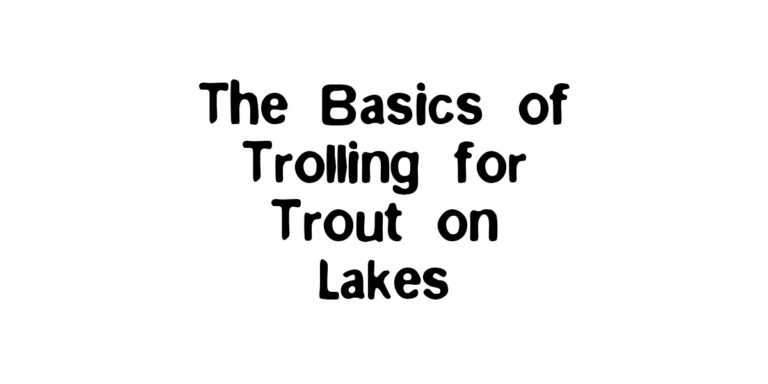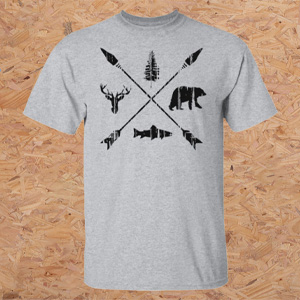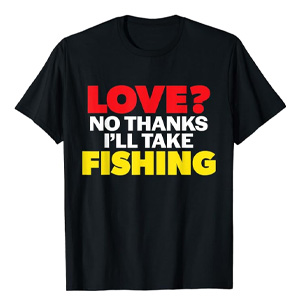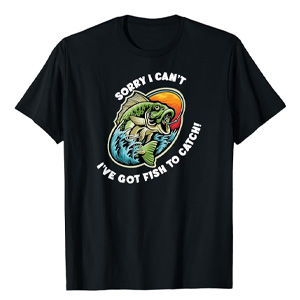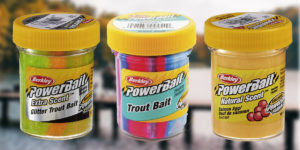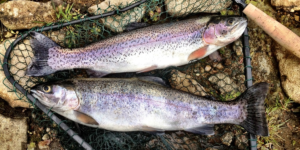*Some of the links in this article contain affiliate links, meaning that I will make a small percentage of any sales made via them. The great overlords of everything feel that you need to know that.
When it comes to trout fishing on lakes, trolling is generally the most effective way to catch trout, particularly large trout. This article will outline how to be successful at trolling for trout on lakes. The basic assumption is that you have a boat with some sort of motor to fish from, so I will cover where to troll for trout, what gear to use and some suggested lures.
Being successful when trout fishing is sometimes a matter of luck, but you can stack your odds in your favor by doing all the right things. This will greatly improve your odds of catching more and larger trout.
- Two types of trout
- Research where to troll for trout
- The thermocline
- Locate structure
- Controlling your depth
- Trout trolling equipment
- Trolling rods and reels
- Line for trolling
- Trolling lures for trout
- Downriggers, divers and weights
- Dodgers, flashers and trolls
- Fish finders
- Final thoughts
Two Types of Trout
One thing we need to address is the two types of trout. I’m not speaking species here such as rainbow, brown and so on, but types. Trout breaks down to either native or holdover planted trout and freshly planted trout.
Established and native trout are survivors. They are smart and cagey. Most of what I have to say here about structure, depth and so on applies to these fish. You have to work for them.
On the other end of the scale are planted trout, typically rainbow trout. These are relatively dumb trout that aren’t smart enough to make use of cover and tend to bite on just about anything.
Research Where To Troll
There used to be a day when being successful at trolling for trout meant repeated trips and lots of trial an error. Now you have the advantage of the Internet and all sorts of information including contour maps of lakes and images of the lake itself and where water flows in and out of it.
Fish the thermocline
The thermocline is the boundary zone where warm water sits on top of colder, oxygen rich water. It usually develops during the late spring and remains a feature in the lake until late fall. Using a fish finder you can usually have no difficulty in locating it.
Native fish or established planted trout from previous year’s plantings will often times will cruise along this layer, moving out of it briefly to feed on creatures above them, then dart back to the safer, dark, oxygenated water.
If you are chasing freshly planted trout however, you can mostly likely ignore the thermocline because, as I mentioned previously, they have not gotten smart yet and will likely be near the surface all day long.
Find the structure in the lake
Using satellite images, you can find out a lot about a lake. You can find where creeks flow in and out of any body of water, and often times get an idea of where weed lines are, as well as other structure in the lake. This will give you more targets to try when you are out fishing.
A favorite of mine, especially on smaller lakes is to target the edges of weed beds early in the morning. Often times I can find a few large trout that way as they are up from the deep waters, looking bugs and small fish in the shallows that will be too warm for them later in the day.
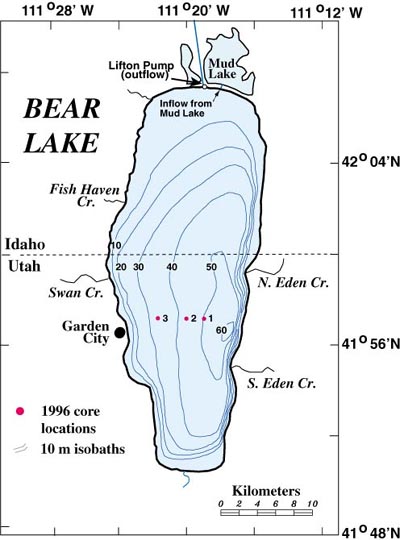
If you combine your satellite images with topographic maps of whatever lake you are wanting to fish, you can dramatically narrow down the ideal areas to target. Established fish will tend to follow things like drop offs and the edges of point, lurking in the darker water.
A quick study of a contour map will show you just where you are likely to find fish holding. Even freshly planted trout, that tend to roam randomly will find areas of cooler, oxygen rich water to hang out in for the bulk of the day and it can sometimes be a very small portion of the lake.
Seasonal changes
Of course of top of this is the season and where fish are moving in the lake as water temperatures change, different food sources become available, and of course as fish move to spawn. To some degree this will all vary from lake to lake and from species to species.
A general guideline is that trout will tend to move to deeper water in the winter months, congregating in the deeper holes, and come up onto ridges and points during the summer months, resting in colder waters and making forays into the shallows to feed.
Spawning will take trout closer to shore or towards the mouths of creeks that they are preparing to migrate up.
4 Ways to Control Your Depth
Trolling a lake may seem straightforward enough, but the biggest factor to a successful fishing trip is putting your lure where fish will see it. We just talked about where on the surface of the lake you want to fish, but we also need to consider how to get your lure down to the right depth consistently.
There are a variety of ways to get your lures down to where the fish are holding. The following are some of the most common.
Diving Lures
If I am out fishing for planted trout first thing in the morning, the first thing I will do is tie on a small Firetiger Rapala. I’ll drag this behind the boat as I get situated and start working toward my chosen fishing area.
Diving lures do exactly what their name suggests, they dive down below the surface when pulled through the water. If you look at each type, it will list the depth to which it will dive. This is affected by the speed at which you are trolling it, as well as the diameter of your line, as it will create drag, pulling your lure up.
Typically you will be able to target the top 5′ – 15′ feet of the water column with diving lures.
Lead Weights
Every fisherman has used lead weight to get their lured down in the water a little farther. The most common example is a couple of split-shot crimped onto your line ahead of a spinner. With trolling, it is the same concept.
For trolling, the most common style of lead weight to use is a banana sinker. This is a chunk of lead formed around a length of bead chain or with simple eyes to tie onto. You can get these in a wide range of sizes and the big advantage to using these over split shot is that they prevent your main line from twisting.
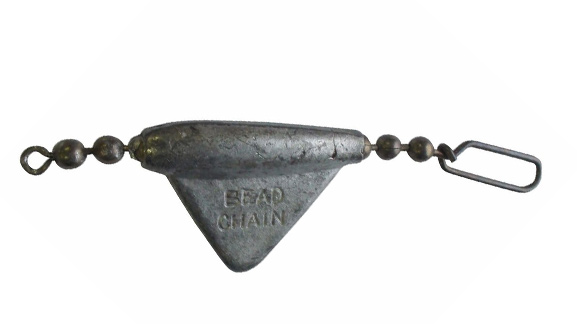
Even when I’m targeting fish in the top layers of the water, I will generally throw on at least a very small keel weight, just to keep any twist from traveling up my line.
In general, using lead weights, you can target fish in the top 50′ of the water column. The downside of course is that the deeper you want to go, the bigger the weight you will need to use which can reduce your ability to feel bites and hamper your fighting the fish.
Divers
The more high tech solution for targeting fish deeper in the lake, without tying on 6oz or more of lead, is to use a diver. These are small pieces of plastic that as you pull them through the water, pull your lure deeper. When a fish bites, the configuration changes and they drop inline, offering minimal resistance to the water.
The big advantage here is that you can get deep without adding a ton of weight to your line. Divers are also a bit more accurate when it comes to targeting your depth. Granted, your choice of main line, trolling speed, and what lures you are using will still affect your final depths, but it is better than with a lead weight alone.
Weighted Lines
Commonly there are three types of weighted lines for fishing. These are lead core, steel wire and copper wire.
I grew up fishing for Kokanee on Priest Lake, dragging around ‘pop gear’ on a thick old lead core line. I think my dad still has reels with that line on it.
There is a lot of debate in the fishing world over weighted lines. On one hand they are a way to get lures deeper without adding a chunk of weight. Pure wire lines have the added advantage of being thin, so they offer less resistance to the water.
The downside of course is that they can be tricky to work with.
A bunch of it comes down to preference, where you are fishing and with what lures.
Downriggers
For really precise depth control, the best way to go is to use a downrigger. This is typically a 5# to 15# lead weight on its own rig equipped with a release that your line is clipped to. The downrigger is put at the depth you want and it takes your lure with it.
When fish bite, your line is releases (usually) and you can fight the fish without the bulk of a weight on the line.
The only real disadvantages to downriggers is the added equipment and of course reeling them up and down if you don’t have electric ones. They are essential though if you want to precisely target a depth.
Trout Trolling Equipment
So far we have talked about macro level things when it comes to trolling for trout. Now we start talking about more specific topics, mainly the tackle that you will do the actual fishing with. When it comes to trolling, the gear you use can make or break you.
Even just narrowing the subject to trolling for trout, leaves us with more than we can cover in one post. The gear that you will use on a small lake, trolling for planter trout that are under one pound will vary greatly from the gear you will use when fishing deep waters for lake trout or mackinaw.
For the purposes of this article, I’ll focus on the basic gear you will need for trolling smaller lakes for planted or even holdover trout.
Rods and Reels
If you are just starting out fishing, you don’t need an ultra expensive trolling rod. Here are some general specs on a basic trolling rod.
- Fiberglass construction
- 6′ to 8′ in length
- ‘Fast’ speed
- Medium light power
- 4-8# line
The above is actually a good general description for an all-purpose trout rod. Let me explain each of these briefly.
Fiberglass construction is preferable because it is more forgiving than a carbon rod. If you overload a carbon rod doing something like pulling on a snag, or jerking it loose of the downrigger, they can just snap.
The 6′ to 8′ length is a bit of a matter of preference and maneuverability. Rods in these lengths are good for trolling with lead or for using on a downrigger.
Fast speed refers to how fast the tip bends when pressure is initially applied to it. Think, when a fish bites. A fast rod will give you more time to respond to a fish biting and more give to fight them with.
Medium light power indicates a moderately stiff rod overall. This is more a measure of how much weight it can pull. A medium light rod will have enough backbone to pull your lures, divers and so on, but not be a broom handle that won’t let you feel anything or fight smaller fish.
4# to 8# line is a measure of how heavily built a rod is. Needless to say a fast rod with medium light power, but built for 30# line will me massively overkill for most trout.
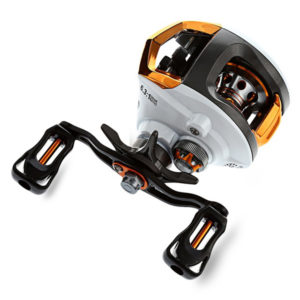
Not on the list, but more a matter of preference, is spinning/casting vs baitcasting. Rods for either have different eyes and aren’t interchangeable. Personally, I prefer a baitcasting reel for trolling, particularly one with a line counter built in. But, if you are building a true multi-purpose rod, then I’d go with spinning so it is easy to cast. It will work for trolling as well, but is less ideal.
Line for trolling for trout
The easiest choice for filling up your reel is monofilament. 4# to 8# test will be strong enough put up with the stress of dragging lures, flashers, weights and other such things, without inducing a large amount of drag. Additionally, it will work for casting as well.
If you are building a strictly trolling rod, a baitcasting reel spooled up with braided line is a good choice. The smaller diameter will make getting deeper easier. Braided line has no stretch which can be a good or bad thing depending on your preferences. When fighting a fish, you will need to rely on the give in your rod to absorb shocks. On the upside, if you need to set a hook, that lack of stretch transfers energy much faster from your rod to the point of the hook.
Trout Trolling Lures
Now we are getting ultra-specific. The actual lures you use when trolling for trout comes down to a synthesis of what trout you are chasing, time of year, personal preference and a multitude of other factors.
Below are some of the main categories of trout lures. My suggestion is to pick one or two and really get good at using them.
My Top 5 Lures For Trolling Lowland Lakes
Trolling Spoons
Trolling spoons come in a wide variety of sizes and shapes, not to mention paint patterns. For small trout, anything from tiny Dick Nite spoons on up to ones about an inch and half in length are a good choice. Do be aware that trolling spoons are different than casting spoons, the main difference being in their thickness.
While you can fish a spoon by itself, it is often times good to fish it behind a dodger to impart some extra flash and action to it.
A small selection of silver and gold colored lures along with the basic painted versions (white, red, black, and green) can be a great start. As you fish a particular body of water, will learn what works in that location.
Plugs
Plugs are one of my favorite things to pull. As I’ve mentioned, early in the morning, I’ll throw out a Rapala Fire Tiger while I’m getting settled in to the morning. One of the more common trout plugs is a flatfish. These come in sizes from as small as 1″ on up to monster 5″ plus plugs for big lake trout.
Flies
Often overlooked by trout fisherman, trolling flies can be very effective, especially for holdover trout. These typically mimic small fish. Favorites include muddlers or small streamers. These need some additional action imparted to them. Flashers, dodgers, and Action Discs will typically do the trick
Wedding rings/spinners
This is a huge category and I’m lumping all the lures that have blades that spin into them. A trolling classic is the Wedding Ring from Mack’s Lures. One of these with a little bit of live bait or powerbait have been very effective for me.
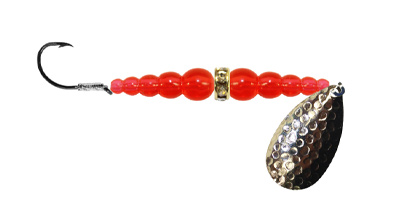
One thing to make sure you do is use some sort combination of rudder or weight and a swivel to prevent any spin going up your main line.
Bait
Worms, maggots, minnows and even powerbait can be drug behind your boat. Generally they are best when combined with a spinner or wedding ring to add some attraction/vibration to the mix. They give the trout some added scent and flavor to entice them to bite.
Quite honestly I can’t imagine just trolling bait on its own without some manner of flasher or spinner to get fish’s attention.
Dodgers, flashers and lake trolls
Part of trolling is trying to cover lots of water to get your lure in front of more fish, but there is also a matter of getting fish’s attention. That is where attractors come in. These add vibration and flash to your presentation.
Dodgers and flashers are effectively large metal or plastic spoons that either swing back and forth or rotate around, both adding flash and action to your lures.
Lake trolls are essentially strings of spinners in a line. these can range from foot line groups of plastic spinners on up to 5′ long arrangements of large metal blades, often times referred to ‘pop gear’.
Their application depends on what you are fishing for, your preferences, and what works for you. Obviously the bigger the attractor, the more drag you will have on your line, and the heavier the rod you will need.
Fish finders
If you are serious about trolling for trout, you really need some sort of fish finder. Now this doesn’t haven’t to be a $5,000 side scanning unit. What I find is that there is a tendency to for people to buy fish finders that have more features than they need and never learn to use their full capability.
One thing you will want to pay attention to is if the display is visible in daylight. Unless you are on a boat with a cabin and some shade, you will want your screen to be visible in at least partial daylight.
What a fish finder will let you do is analyze the depth accurately, that the bottom structure is and even follow contours. You can study maps all you want, but being able to accurately see what is down there is a whole different thing all together.
Final thoughts on trolling for trout
Trolling for trout is something that anyone with a boat can do, and is highly productive technique for catching fish. The more you practice, test and experiment, the higher your success rate will be.
Every lake is a little different and even the same species of trout in different bodies of water. Water color, time of year, and so on, all affect what does the trick for putting fish in the boat. Do your research and see what has been working for other people, test new lures, and keep a record of what you caught, when, where and with what lure.
This is why I suggest picking 2 go-to types of lures and getting very experienced with them. I can tell you that I’ve never had great success with KwikFish tupe lures. I can also tell you that the reason for this is that I’ve never put in the time to learn to fish them correctly.
I know you will hate this as a final thought, but go fish more. The more you fish, the better you will get at it!

